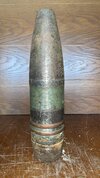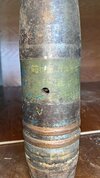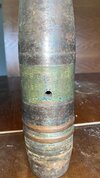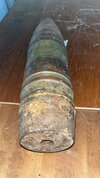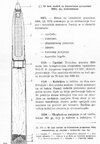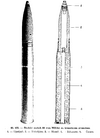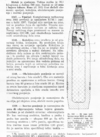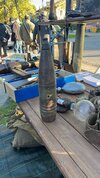I submit to you some images of a 75 mm that I would like to identify. Thank you
British Ordnance Collectors Network
You are using an out of date browser. It may not display this or other websites correctly.
You should upgrade or use an alternative browser.
You should upgrade or use an alternative browser.
75 mm id
- Thread starter bombista
- Start date
Eggburt1969
Well-Known Member
As mentioned above, Yugoslav and it would seem to be 85 mm and not 75 mm.
If Yugoslav, the projectile markings would be in the format listed below.
Fist Row: The calibre and designation of the weapon the projectile is used by.
Second Row: Type (nature) of the projectile and its designation.
Third Row: Production details.
If Yugoslav, the projectile markings would be in the format listed below.
Fist Row: The calibre and designation of the weapon the projectile is used by.
Second Row: Type (nature) of the projectile and its designation.
Third Row: Production details.
Eggburt1969
Well-Known Member
Yes, my thoughts was a Yugoslav 85 mm drill round based on the body of an inert and modified high explosive projectile: 53-O-365K or M68. The holes in shell's sidewall and the threaded hole in the base you can see further reinforce this hunch.
I can't really make out all the middle row markings on the projectile, where its nature and designation are, but there's seems to be a '3' after the first hyphenated character and then either a '5' or a '6'?
PS What publication was the above diagram from? I've got some similar regional publications from 1974, but not that one.
Yes, my thoughts was a Yugoslav 85 mm drill round based on the body of an inert and modified high explosive projectile: 53-O-365K or M68. The holes in shell's sidewall and the threaded hole in the base you can see further reinforce this hunch.
I can't really make out all the middle row markings on the projectile, where its nature and designation are, but there's seems to be a '3' after the first hyphenated character and then either a '5' or a '6'?
PS What publication was the above diagram from? I've got some similar regional publications from 1974, but not that one.
I can make out TREN O-365, but it must be the remains of the original painting before reworking the HE shell. There is some blue paint that might have been applied as the new marking.
The diagram is from "ARTILJERIJSKA MUNICIJA Knjiga VI" of 1965. I made it available here.
PS.: M68 is made to accept the PD.M48 fuze, so it has a larger diameter fuze well.
Last edited:
Eggburt1969
Well-Known Member
I guess it was an O-365K (53-O-365K), and not O-365 (53-O-365), as the former is the version for the far smaller KTM impact fuze series.I can make out TREN O-365, but it must be the remains of the original painting before reworking the HE shell. There is some blue paint that might have been applied as the new marking.
The diagram is from "ARTILJERIJSKA MUNICIJA Knjiga VI" of 1965. I made it available here.
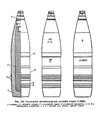
53-O-365K one-piece version, there's also an earlier two-piece version with a fuze adapter (see below).
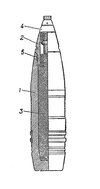
The O-365 being the earlier (primarily) anti-aircraft projectile for use with longer length and larger rear diameter fuzes, such as the T-5 pyrotechnic time and impact.
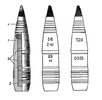
Last edited:
Nice documentation, thank you.I can make out TREN O-365, but it must be the remains of the original painting before reworking the HE shell. There is some blue paint that might have been applied as the new marking.
The diagram is from "ARTILJERIJSKA MUNICIJA Knjiga VI" of 1965. I made it available here.
PS.: M68 is made to accept the PD.M48 fuze, so it has a larger diameter fuze well.
Obviously. The manual mentions the O-365K too. I didn’t state the K only because it wasn’t readable.I guess it was an O-365K (53-O-365K), and not O-365 (53-O-365), as the former is the version for the far smaller KTM impact fuze series.
View attachment 199886
53-O-365K one-piece version, there's also an earlier two-piece version with a fuze adapter (see below).
View attachment 199884
The O-365 being the earlier (primarily) anti-aircraft projectile for use with longer length and larger rear diameter fuzes, such as the T-5 pyrotechnic time and impact.
View attachment 199885
A little correction: the T-5 doesn’t have an impact feature
Eggburt1969
Well-Known Member
Ah, yes, the thing above the detonator slider/shutter is its inertia (firing acceleration) locking plunger. It been ages (many, many years ago) since I wrote the entry on the T-5 and was getting it mixed up with the T-6, T-7, etc.Obviously. The manual mentions the O-365K too. I didn’t state the K only because it wasn’t readable.
A little correction: the T-5 doesn’t have an impact feature

